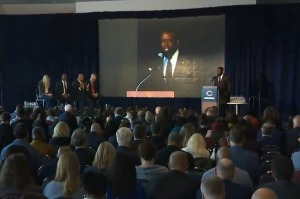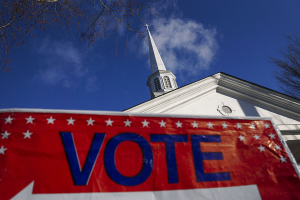Denver's Parks Include 13,000-foot-high Lake
DENVER (AP) - Some city parks have gazebos, lakes, fountains and jogging trails. Denver's parks have those, plus: a 1,000-year-old fen, two bison herds, a ski resort, a lake at 13,000 feet in altitude and an amphitheater framed by 300-million-old sandstone monoliths.
Denver has 20,000 acres of parks and the bulk — 14,000 acres — are spread through the mountains west of the city.
Denver also boasts the country's highest city park: Summit Lake Park at 13,000 feet, on the road to the summit of 14,264-foot Mount Evans, about 60 miles southwest of Denver.
Red Rocks Park, in the foothills 18 miles west of Denver, has picnic sites, trails, buildings constructed by the New Deal-era Civilian Conservation Corps and a world-renowned amphitheater nestled between 300-foot, red sandstone formations that rise out of the ground, jutting toward the sky. The Beatles took the stage there in August 1964. Rock group U2's 1983 rain-drenched concert at Red Rocks spawned a famous video of their performance of "Sunday Bloody Sunday."
"Red Rocks is one of the places you take your cousins when they're in town," said Susan Baird, Denver's natural resources planner.
Another top tourist spot is William "Buffalo Bill" Cody's grave and museum on top of Lookout Mountain in the west metro area, also a Denver city park.
Baird said even locals are often surprised that some of their favorite getaway spots are Denver city parks.
"In one day, you can play golf, see a Moody Blues concert, a baby bison, a 1,000-year-old fen — all in the Denver parks system," Baird said. The fen, a peat bog and wetland, is at Echo Lake Park on the road to Mount Evans.
The outline of what city leaders fashioned as a gateway to the mountains was first sketched in 1911 under the leadership of business groups and Mayor Robert Speer. A report by a special parks committee of the chamber of commerce called the project "the first step, perhaps the greatest step, in the great movement of making our mountains available for the people."
Mile-high Denver sits at the intersection of plains and mountains.
Business people were also convinced the parks would make Colorado "more attractive to tourists than Switzerland" and extolled the mountains' cool weather and "invigorating atmosphere."
Baird said a local forerunner of the American Automobile Association was also eager to promote trips to the mountains. Drivers used wells and springs in the parks to refill their cars' radiators.
People also rode trolleys, trains and funiculars — incline railways — to some of the parks.
In 1912, Denver voters overwhelmingly approved a tax to fund the system. Frederick Law Olmsted, one of the architects of New York's Central Park, was hired to highlight potential sites.
Denver's first acquisition was Genesee Park, the largest of the mountain parks at 2,413 acres. Genesee, 20 miles west of Denver and dissected by Interstate 70, is home to one of the system's two bison herds of 24 animals each. In 1914, the city fenced off 160 acres for elk and bison shipped in from Yellowstone National Park.
The other bison herd is in Daniels Park, 21 miles south of Denver.
Work began in 1913 on Lookout Mountain Road 15 miles west of Denver. It was part of the 63-mile Lariat Trail that started in Denver and wound through the mountains.
The parks include several historic buildings, some built by workers of the Civilian Conservation Corps and Works Progress Administration and designed by the National Park Service. There's Genesee Park's Chief Hosa Lodge and Echo Lake Lodge in Echo Lake Park, both built with timber and stone from the area.
Baird said Denver acquired land from the Forest Service that in some cases is inaccessible but has kept mountain backdrops free of development.
In 1939, Denver added a ski area to its mountain parks. George Cranmer, who became the city's park manager, wanted to give Denver children opportunities to ski. The city bought 90 acres of land from the U.S. Forest Service about 65 miles west of Denver.
Several public forums, surveys and focus groups have shown the parks are heavily used, Baird said, getting about 2.5 million visitors yearly, with 300,000 to 400,000 coming from Denver.




























